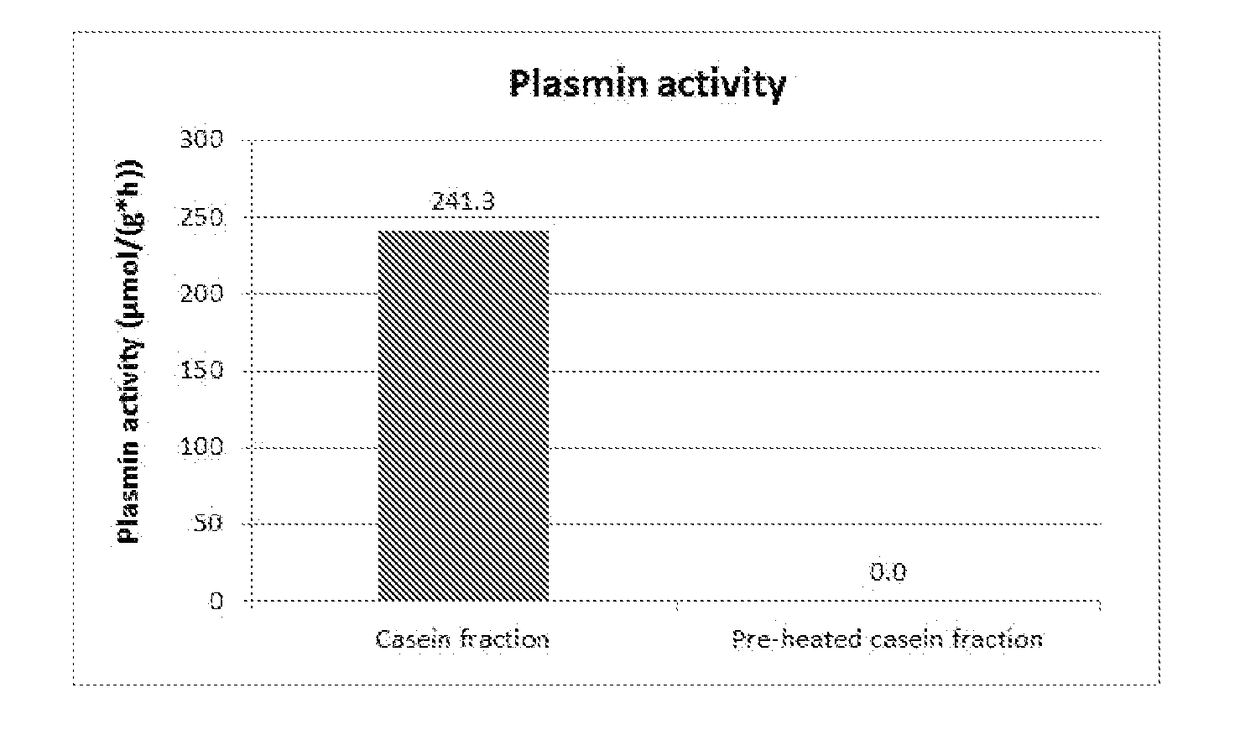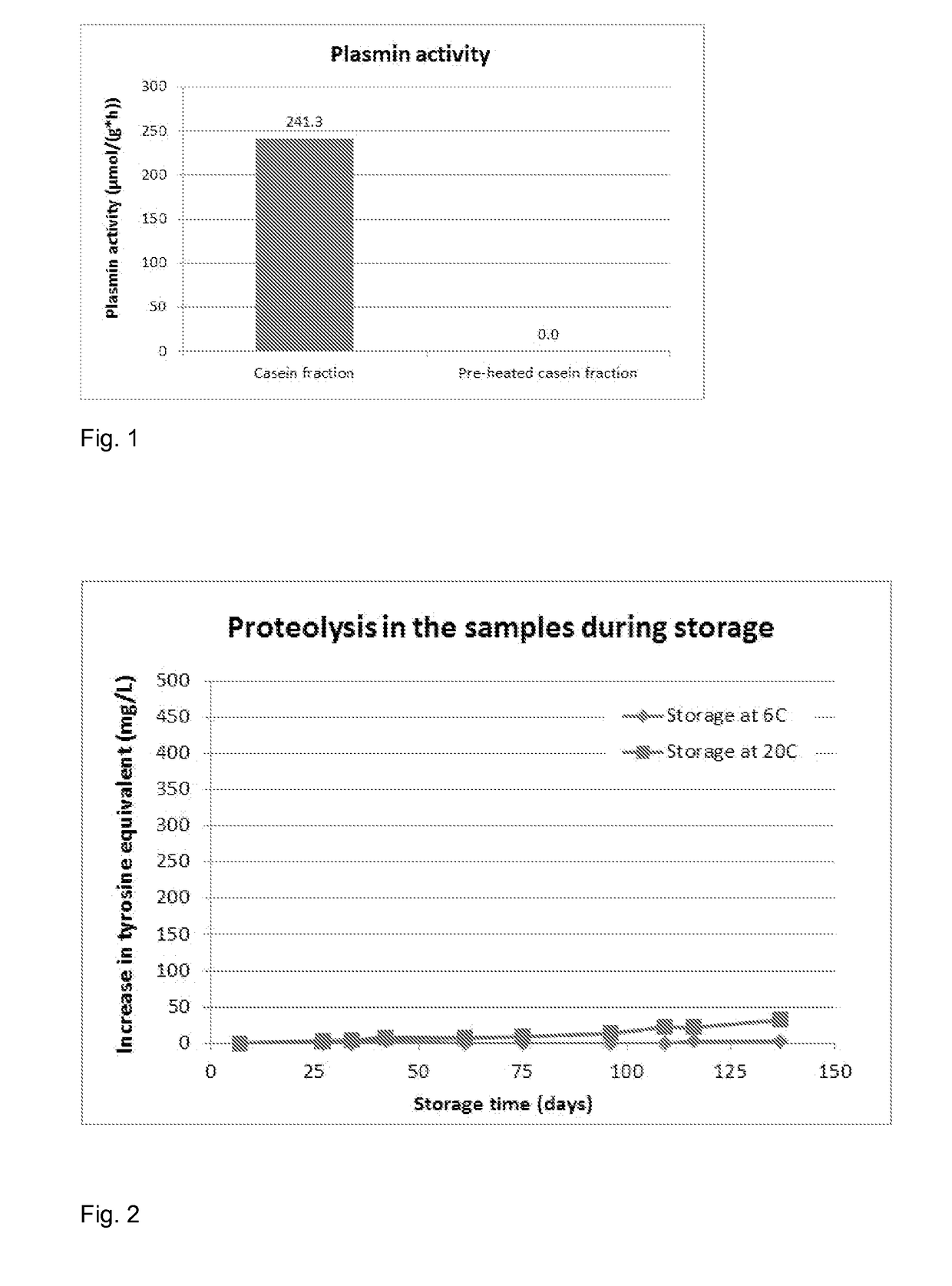Method for producing a milk-based product with reduced plasmin-activity
a technology of plasmin-activated milk and plasmin-free milk, which is applied in the field of milk-based products production, can solve the problems of reducing the content of whey protein, reducing the shelf life of milk products stored at room temperature, and not necessarily inactivating enzymes by treatment, so as to reduce the content of whey protein and prolong the shelf life. , the effect of reducing the content of maillard reaction
- Summary
- Abstract
- Description
- Claims
- Application Information
AI Technical Summary
Benefits of technology
Problems solved by technology
Method used
Image
Examples
example 1
n of Milk by Membrane Filtration
[0080]Skim milk was ultrafiltrated by a volumetric concentration factor (VCR) of 3.7 at about 10° C. The membrane used in the ultrafiltration was Koch HKF 131 from Koch Membrane Systems, Inc. Table 1 shows the compositions of skim milk and of the obtained milk protein concentrate, that is the ultrafiltration retentate.
example 2
n of Milk by Membrane Filtrations
[0081]Skim milk was microfiltrated at a temperature range from 10° C. to 15° C. at a pressure of less than 1.5 bar to concentrate casein in the microfiltration retentate. The membrane used in the microfiltration was Synder FR from Synder Filtration, Inc. The skim milk was first microfiltrated by a concentration factor of about 4. The microfiltration was then continued by means of diafiltration, in which tap water was added to the obtained microfiltration retentate in an amount equal to that of the obtained retentate. The microfiltration was continued until an equivalent amount of the obtained permeate, compared to the amount of added water, was discharged. The diafiltration step was repeated two times. Permeates obtained from the two diafiltration steps were combined and the combined mixture was ultrafiltrated at a temperature range from 10° C. to 15° C. using the Koch HKF 131 membrane to concentrate whey protein in the ultrafiltration retentate. The...
example 3
on of a Skimmed Milk Product According to the Method of the Invention
[0085]A skimmed milk product was prepared with the method of the invention. The casein concentrate obtained in Example 2 was thermally pre-treated by indirect heating (95° C., 5 min) to inactivate plasmin enzyme. Samples were taken from the casein concentrate before and after the thermal pre-treatment step. Plasmin activity in the casein concentrate before and after the thermal pre-treatment is presented in FIG. 1. The result shows that plasmin activity can be fully inactivated by thermal pre-treatment carried out for the casein concentrate.
[0086]The thermally pre-treated casein concentrate together with other membrane filtration fractions obtained in Example 2 was used for the preparation of a skimmed milk product. The recipe and composition of the skimmed milk product are presented in Table 2. The components were combined and thoroughly mixed. The mixture was heat-treated at 157° C. for 0.1 sec by direct steam in...
PUM
 Login to View More
Login to View More Abstract
Description
Claims
Application Information
 Login to View More
Login to View More - R&D
- Intellectual Property
- Life Sciences
- Materials
- Tech Scout
- Unparalleled Data Quality
- Higher Quality Content
- 60% Fewer Hallucinations
Browse by: Latest US Patents, China's latest patents, Technical Efficacy Thesaurus, Application Domain, Technology Topic, Popular Technical Reports.
© 2025 PatSnap. All rights reserved.Legal|Privacy policy|Modern Slavery Act Transparency Statement|Sitemap|About US| Contact US: help@patsnap.com


